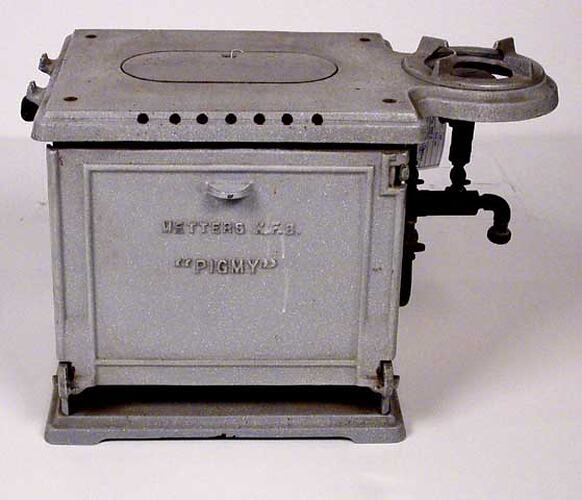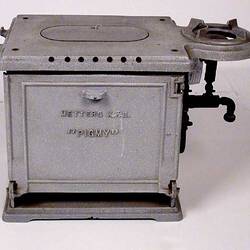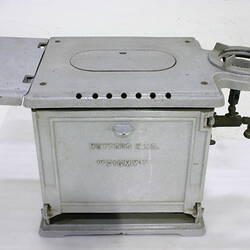Summary
Portable gas Metters KFB Pigmy stove, of squat square construction in grey enamel.
It was used in West Preston, Victoria by the donor's in-laws. The donor built his home in 1936 and set up an extra room for his in-laws who came to live with him. The Pygmy stove was purchased specifically for his in-laws; at the time it was considered suitable for their cooking needs. However the two couples decided to eat together and the stove was used only a few times. The in-laws lived with the donor until 1947 when they went to live in Ballarat; they undertook their journey in a horse-drawn caravan. When the donor's house was sold in 1993, the stove was passed on to the donor's agent who arranged its donation to Museum Victoria.
Physical Description
A gas, portable stove. Squat square construction in grey enamel. TOP: 2 hotplates, 1 elongated oval centre of unit, one circular at side of unit with two peg holes. 7 ventilation holes along front edge, 9 along rear edge. FRONT: oven compartment. DOOR: cast with maker's name and model at centre. Hinged lower left and right. HANDLE - flattened disk, upper centre. INTERIOR: 6 brackets for shelves. 1 solid metal baking tray. 1 tray with wire shelf insert.1 wire shelf. 2 gas burners run along length lower left and lower right. SIDE: Right: exposed burner with pipes to external gas supply. 3 small taps to control flow of gas. Pipe runs down to lower edge and to back of stove. Left: black handle upper centre. 2 struts upper edge. BACK: 5 ventilation holes across top. Gas supply pipe along lower edge, feeds into oven lower left and right.
Significance
Solid fuel stoves continued to be manufactured for the Australian consumer throughout the early decades of the 20th century. In urban areas solid fuel was eventually replaced by gas or electricity.
Access to power supplies impacted significantly upon the market for gas and electric stoves. Though cooking in electric ovens was advertised from the outset as 'cleaner and more efficient', in the 1920s only 34% of all houses in Victoria were wired for electricity. Gas was available to many more Australian homes and consequently gas stoves, which were cheaper to purchase, cheaper to run, and required no installation fee, sold in greater numbers than electric stoves.
In the early 1920s, electric stoves were being imported into Australia. High tariffs meant these stoves were incredibly expensive; coupled with installation and running costs, it is not surprising that in 1923, only 0.1% of the population owned an electric stove. Despite the fact that over 80% of homes in Australia were wired for electricity by 1947, an estimate of electric stove ownership for 1955 indicates take up to be low: 36% of homes in Brisbane, 25% in Sydney and 24% in Melbourne. (Dingle 1998)
More Information
-
Collecting Areas
-
Acquisition Information
Donation from Mr George McIntosh, Aug 1994
-
Place & Date Used
Mr George McIntosh, Preston West, Greater Melbourne, Victoria, Australia, 1937-1947
Used by the donor's in-laws, Mr & Mrs Harrison. -
Inscriptions
FRONT: DOOR: "METTERS K.F.B./ "PIGMY" "
-
Classification
-
Category
-
Discipline
-
Type of item
-
Object Measurements
37 cm (Length), 65 cm (Width), 35 cm (Height)
Unit with shelf added.
-
Keywords


